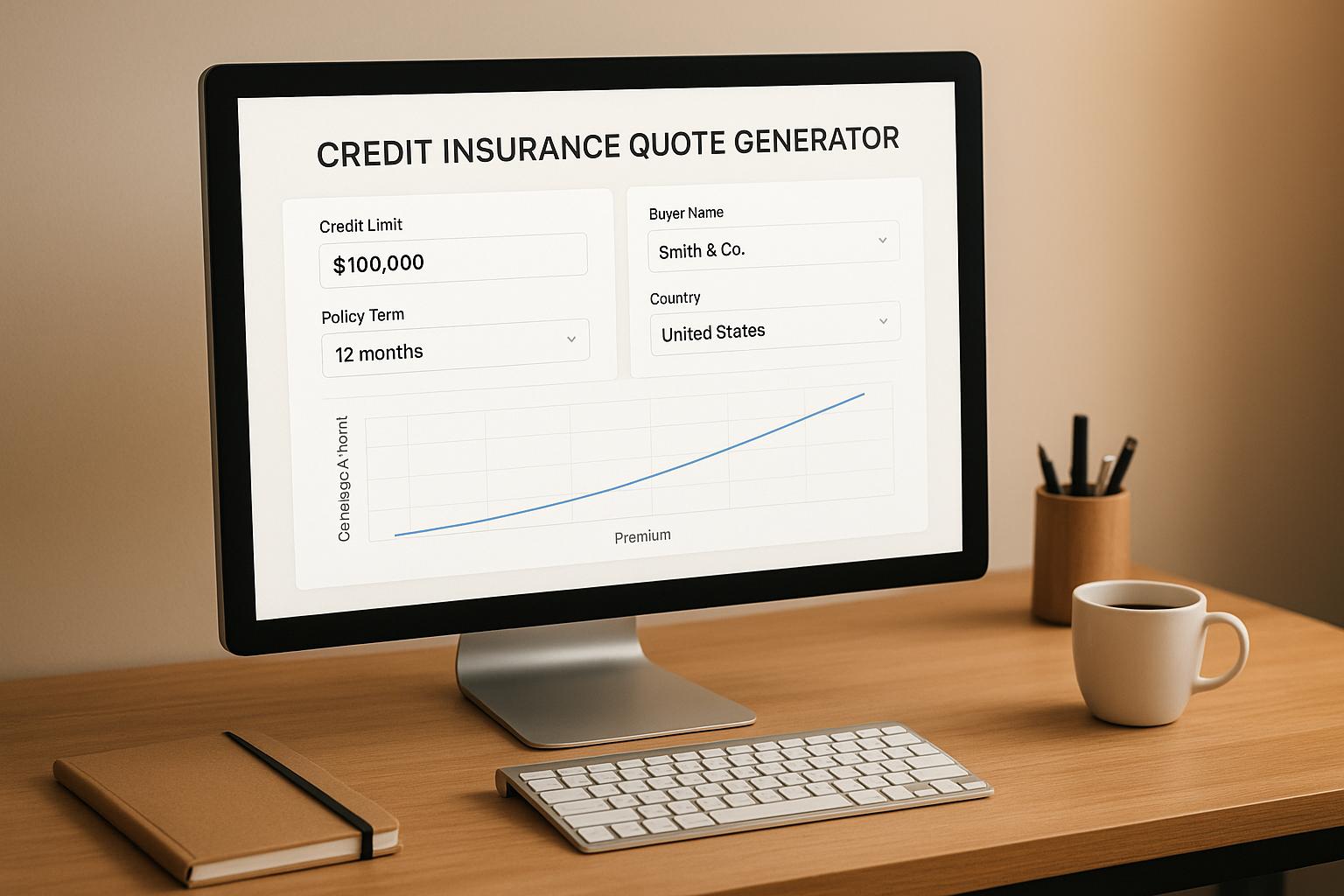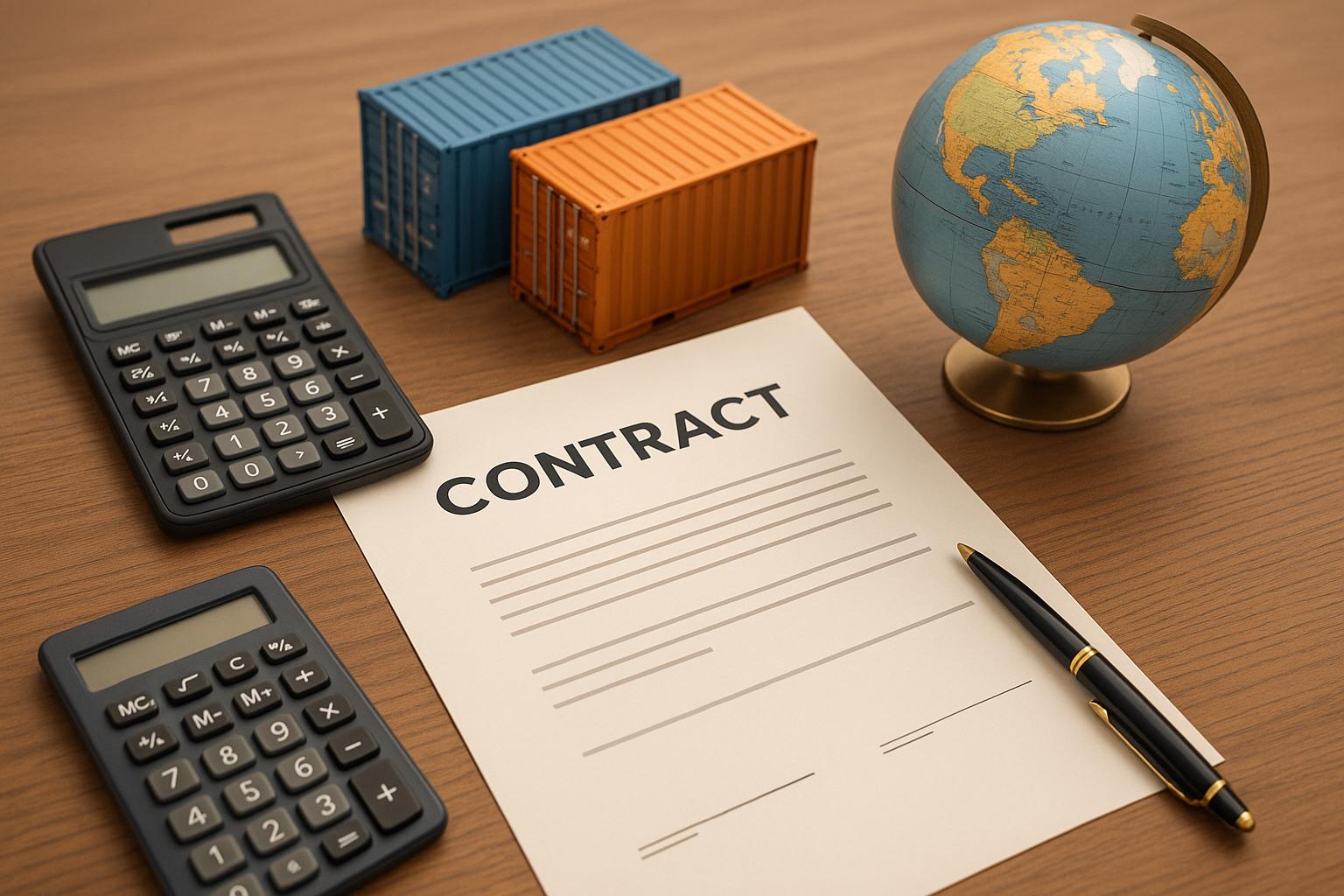Credit risk in global trade is a growing challenge. Businesses face financial losses when payments are delayed or missed, especially in international transactions impacted by economic shifts, political tensions, and industry-specific issues. Here’s a quick breakdown of the key takeaways:
Key Points:
- Economic Volatility: High interest rates, inflation, and declining consumer confidence increase payment delays and defaults.
- Political Instability: Trade wars, sanctions, and geopolitical tensions disrupt payments and partnerships.
- Industry-Specific Risks: Sectors like automotive and logistics face higher default probabilities due to complex supply chains and rising costs.
- Rising Corporate Bankruptcies: 2023 saw record insolvencies, creating ripple effects across global supply chains.
- Solutions: Trade credit insurance, regular risk assessments, and tailored credit policies help mitigate risks.
Why it matters: Effective credit risk management is essential for businesses to protect their financial health and maintain global trade operations. By addressing these risks proactively, companies can safeguard their bottom line and seize new opportunities.
Credit Insurance as a Risk Mitigation Tool for International Trade
Main Credit Risk Factors in Global Trade
Global trade operates in a complex environment influenced by various risks. Three primary categories stand out: economic volatility, political instability, and industry-specific factors. Together, these elements shape the unique credit challenges faced in international trade.
Economic and Market Changes
Economic turbulence plays a major role in shaping credit risks. Factors like rising interest rates, persistent inflation, and declining consumer confidence directly impact businesses’ ability to meet their financial obligations. For instance, company insolvencies in England and Wales recently reached their highest levels in three decades. In 2023, financial uncertainty was the top concern for UK businesses, with over one-third of business leaders identifying it as their primary worry.
High interest rates create cash flow challenges, particularly for businesses carrying significant debt or those reliant on financing inventory. At the same time, inflation forces companies into tough decisions: raise prices and risk losing customers, or absorb costs and strain their own margins. Both scenarios can lead to delayed payments and strained relationships with trading partners.
The interconnected nature of global markets further amplifies these risks. Economic slowdowns in one region often ripple across borders, impacting trading partners worldwide. Sluggish global growth, rising energy costs, and elevated interest rates all contribute to an increased likelihood of payment delays or defaults.
Political Tensions and Trade Barriers
Geopolitical tensions add another layer of complexity to credit risk. Political instability and trade conflicts disrupt established business relationships and create uncertainty, which often leads to payment delays or defaults.
A clear example is the U.S.-China trade war, which significantly affected global trade dynamics. Research revealed a 34% increase in firm exits from China due to heightened political risks during the trade war. Companies were forced to re-evaluate their partnerships and renegotiate payment terms, illustrating how political disputes can reshape credit risk landscapes.
"The trade war and tariffs in particular have caused a lot more collateral damage than targeted damage. Multinational corporations have found China to be a less attractive place because of the cycle of retaliations that are part of increased geopolitical tension." – Jack Zhang, Assistant Professor of Political Science at the University of Kansas
Sanctions further complicate matters, as they often prevent businesses from completing transactions or receiving payments, even when the underlying relationships remain solid. Trade credit professionals frequently report the ripple effects of such disruptions. Ryan Steiner, corporate credit manager at Olympic Steel, Inc., highlights the practical challenges:
"Whether it’s a freighter blocking the Panama Canal or fuel shortages in Russia, any disruption in the global supply chain tends to delay payments in the following months."
Industry-Specific Risk Factors
Credit risks also vary significantly by industry, depending on factors like supply chain complexity and market conditions. Industries with highly integrated global supply chains – such as automotive, transportation, and building materials – are particularly vulnerable. Tariffs, weakened demand, and squeezed profit margins have led to deteriorating credit outlooks in these sectors.
Debt-to-income (DIN) ratios highlight the strain across industries. For example:
- U.S. auto and parts producers: 25.9%
- Canadian auto suppliers: 21.7%
- Canadian forestry firms: 31.2%
- U.S. trucking companies: 25.8%
- Chinese technology firms: 25.9%
The broader picture is equally concerning. In February 2025, Credit Benchmark estimated the average probability of default among global corporate borrowers at 0.55%, exceeding levels seen during the height of the Covid pandemic in 2020. For high-risk sectors, these probabilities are even higher, with some automotive suppliers facing a 2% chance of default.
In response to these pressures, businesses are increasingly requesting extended payment terms. Jessica Riviere, senior director of credit and collections at BDP International, Inc., explains:
"We are experiencing ongoing requests for longer payment terms from our existing and new customers alike. They now see the high costs associated with transportation and subsequently goods because of the pandemic, so seeking extended terms allows companies to better manage their working capital."
These industry-specific challenges underline the importance of customized risk management strategies for businesses engaged in global trade.
How to Reduce Credit Risks in International Trade
Managing credit risks in international trade requires a mix of tried-and-true methods and modern financial tools to protect businesses from potential losses.
Benefits of Trade Credit Insurance
Trade credit insurance acts as a financial safety net for companies involved in global trade. It protects against losses caused by customer insolvency, bankruptcy, or political instability. Depending on the policy, it can cover 75% to 95% of unpaid invoices, offering businesses the stability needed to handle payment defaults. Considering that customer insolvency and defaults contribute to 25% of corporate bankruptcies, this protection is critical for keeping operations on track.
Another advantage is improved access to financing. Banks often view insured businesses as lower-risk borrowers, making it easier to secure funding. And the cost? For most multi-buyer policies, premiums are typically less than 1% of insured sales. Larger companies, especially those with annual revenues above $20 million, usually see premium rates between 0.1% and 1% of their turnover. This affordability makes trade credit insurance an appealing option for businesses of all sizes.
Ongoing Risk Assessment and Tailored Policies
Effective risk management starts with regularly assessing the financial health of trading partners. Businesses can use tools like credit scoring models and stay updated on key economic indicators. These evaluations should happen annually at a minimum, with additional reviews triggered by major market changes or new regulations.
Setting credit limits involves balancing customer demands with a company’s risk tolerance. Standardized credit policies across the organization ensure consistent evaluations. These policies should include streamlined onboarding processes and approval workflows to maintain efficiency. Digital tools, such as accounts receivable automation, can make a big difference – reducing delinquencies by 49% and improving days sales outstanding by 66%. Well-defined contracts with clear payment terms and dispute resolution clauses also help prevent misunderstandings that might delay payments.
Accounts Receivable Insurance Solutions
Building on strong risk evaluations, ARI offers specialized solutions for managing credit risks in both domestic and international trade. ARI’s approach begins with comprehensive risk assessments, helping businesses identify areas of exposure and craft strategies tailored to their unique challenges. These assessments consider factors like industry specifics, the location of trading partners, and individual business models.
ARI doesn’t stop at policy design – it also provides proactive support to address potential payment issues early. With access to a global network of carriers, ARI ensures companies receive coverage that aligns with their geographic and industry needs. By combining thorough assessments, customized policies, and continuous support, ARI helps businesses navigate the complexities of international trade while minimizing credit risks.
sbb-itb-2d170b0
Future Trends in Credit Risk Management
The world of global trade credit risk is evolving quickly, shaped by economic instability and new challenges that businesses could hardly have anticipated just a few years ago. To navigate these shifting dynamics, companies must stay informed and prepared to adapt to emerging risks.
Economic Shifts and Their Effects
Economic unpredictability has become the norm, with credit conditions worsening in many regions. According to Credit Benchmark, their "DIN" ratio – tracking internal bank downgrades versus upgrades – has shown a troubling trend, with global corporate credit downgrades outpacing upgrades for 27 consecutive months. Over the last four months, net downgrades have exceeded upgrades by 4%, signaling mounting financial strain on businesses.
This growing risk stems from a mix of rising interest rates, persistent inflation, and ongoing regional conflicts that have been escalating since 2023.
"Credit risk was rising across the globe before the trade war started. Those headwinds could now get stronger, especially in trade-exposed industries." – Michael Crumpler, Credit Benchmark CEO
Currency volatility is another major concern, as fluctuations can erode profit margins and alter the value of foreign assets and liabilities. For businesses operating across multiple currencies, these swings can turn profitable deals into financial losses almost overnight.
The cost of mitigating these risks has also risen sharply. Research shows that for U.S. corporate sectors, the cost of hedging against credit risk increased by around 40 basis points between January and April 2025. For every additional 100 basis points of default risk, hedging costs jumped from 60 basis points to 110 basis points.
Trade finance, a critical component supporting over $10 trillion in annual transactions and generating $18 billion in global bank revenues, is under particular strain. As borrower cash flows become less reliable, banks are tightening lending standards, which reduces the availability of trade credit. This creates a vicious cycle: less financing leads to lower trade volumes, further pressuring businesses already dealing with credit risks. Beyond these economic challenges, environmental and cybersecurity risks are becoming equally pressing issues.
Climate and Cyber Risk Effects
Adding to the economic pressures, climate change and cybersecurity threats are reshaping how credit risks are assessed. In 2024 alone, natural disasters caused $417 billion in direct economic losses worldwide, with 63% of these losses uninsured. Under current policies, global temperatures are projected to rise by as much as 3.1°C by the end of the century, potentially driving these costs even higher.
Financial institutions are increasingly factoring climate-related risks into credit evaluations. For instance, Moody’s reported that Boeing‘s expected default frequency surged 17-fold between January 2019 and May 2020 due to the 737 MAX crisis and the pandemic. Climate-adjusted scenarios suggest Boeing‘s default probability could rise by 25 basis points under moderate physical risk, and by 50 basis points in a high-risk scenario by 2035.
Regulatory demands are also intensifying. Companies now face mounting pressure from investors and regulators to disclose emissions and set reduction targets, adding compliance costs and potential reputational risks for those that fail to act decisively.
Cybersecurity risks present another growing challenge. About 75% of third-party vendor breaches target technology and software supply chains, while 29% of all data breaches are linked to third-party attacks. Industries like transportation and logistics, vital to global trade, are particularly vulnerable as cyberattacks become more frequent and expensive.
The intersection of trade tensions and cyber risks compounds these challenges. Harmful policy interventions in global trade and investment have surged, increasing from 600 in 2017 to over 3,000 annually between 2022 and 2024. In the rush to secure alternative suppliers, businesses often bypass critical security checks, inadvertently exposing themselves to cyber threats.
"These tariffs will create real cyber risks. When firms rush to find new suppliers, they often skip proper checks. This opens doors to cyberattacks. At the same time, nation-states may launch more cyberattacks as payback." – Kip Boyle, vCISO, Cyber Risk Opportunities LLC
A shortage of skilled cybersecurity professionals further complicates matters, with an estimated 4 million cyber specialist jobs unfilled as of 2020. Despite these challenges, advancements in technology offer opportunities to strengthen risk management. Banks are ramping up investments in digital tools as customers increasingly prioritize seamless trade processes and top-tier service.
"Despite ongoing headwinds, we are seeing the trade and supply chain finance market continue to evolve rapidly. Banks are observing that customers are now prioritising leading service and digital capabilities more than ever, driving a step-change in investment by banks in technology to accelerate seamless trade." – Ravi Hanspal, Partner at BCG
These trends highlight the need for modernized approaches to credit risk management. Companies must integrate climate risk assessments into their monitoring processes, diversify supplier networks to minimize geographic concentration, and adopt robust cybersecurity measures across their supply chains. By addressing these challenges head-on, businesses can better position themselves to manage the risks of an increasingly complex global trade environment.
Conclusion: Managing Credit Risks in Global Trade
Global trade faces a complex mix of challenges, from economic uncertainty and geopolitical tensions to the growing threats of climate change and cybersecurity issues. With global GDP growth expected to slow to 2.4% by 2025 and trade growth projected to dip from 3.3% in 2024 to just 1.6% in 2025, effective credit risk management is more crucial than ever.
Defaults remain a major driver of bankruptcy risks, and accounts receivable often account for as much as 40% of a company’s assets. For businesses operating on an international scale, these risks are even more pronounced.
The key to mitigating these challenges lies in proactive planning. Companies can strengthen their foundations by conducting in-depth credit investigations on trading partners, diversifying client portfolios across industries and regions, and maintaining ongoing monitoring systems to catch early signs of potential defaults. While internal measures are vital, they must be complemented by external solutions to provide a comprehensive safety net.
In today’s volatile global environment, self-reliance alone is not enough. Trade credit insurance has become an indispensable tool for safeguarding financial stability. Beyond protection, it also enhances a company’s competitive edge. As Mike Libasci, President of International Fleet Sales, explains:
"Accounts receivable insurance has allowed us to take on customers and transactions we wouldn’t have felt comfortable taking on by ourselves. It has not only allowed my company to take on larger deals, but be more liberal in terms, and the result has gone straight to our bottom line."
The financial stakes are clear. For a company with a 5% profit margin, a $100,000 debt loss would require generating $2 million in new sales to recover the lost profit. By comparison, the cost of trade credit insurance – typically less than 1% of sales – is a small price to pay for such critical protection.
Accounts Receivable Insurance offers tailored solutions to meet the unique needs of businesses, covering both domestic and international markets. With access to databases monitoring millions of companies worldwide and the ability to process most credit limit requests in under 48 hours, businesses can act quickly and confidently, all while maintaining competitive credit terms.
Michael Salerno, Vice President of International Banking, underscores this point:
"Risk management is no longer optional. It needs to be an integrated part of a company’s global trade strategy."
The companies that will succeed in this uncertain environment are those that view credit risk management not as an expense, but as a strategic tool for growth. By combining thorough due diligence, diversified client bases, continuous monitoring, and comprehensive insurance coverage, businesses can navigate uncertainty while capitalizing on new opportunities in the global marketplace.
Investing in strong credit risk management isn’t just about protection – it’s about positioning your business for long-term success.
FAQs
What is trade credit insurance, and how does it protect businesses in global trade?
Trade credit insurance offers businesses a safety net against the financial risks of unpaid invoices. If a buyer cannot pay due to reasons like insolvency, default, or political issues, this insurance typically covers up to 90% of the unpaid invoice amount.
Beyond just financial protection, trade credit insurance often includes valuable services such as evaluating the creditworthiness of buyers, assisting with debt collection, and providing continuous risk monitoring. These features enable businesses to extend credit with greater confidence, ensuring cash flow remains secure while pursuing growth opportunities in both domestic and international markets.
What are the main economic and political factors affecting credit risk in global trade today?
Economic and political dynamics heavily influence credit risk in global trade. On the economic front, changes in trade policies, such as tariffs and protectionist measures, have created obstacles for export-driven markets. These challenges often slow growth and lead to greater currency volatility. Moreover, the uneven post-COVID economic recovery has strained businesses’ ability to handle debt and secure refinancing, particularly in regions with weaker credit ratings.
From a political perspective, geopolitical tensions and military conflicts continue to disrupt trade routes and supply chains, increasing the chances of payment defaults. Similarly, political instability in emerging markets – whether through regime changes or sudden policy shifts – can add further uncertainty for companies involved in international trade. Together, these factors highlight the need for vigilant risk management to maintain financial stability in an unpredictable global environment.
What strategies can businesses use to manage credit risks in industries like automotive and logistics?
To tackle credit risks in industries like automotive and logistics, businesses should adopt proactive strategies that prioritize preparation and adaptability. A good starting point is conducting in-depth credit assessments of trading partners. This means evaluating their financial stability and ability to meet payment obligations – a step that’s especially critical during periods of economic uncertainty or market fluctuations.
Another essential tool is trade credit insurance, which acts as a safety net against risks like non-payment or insolvency. This type of insurance provides financial security, giving businesses confidence when dealing with both domestic and international partners.
Building and maintaining strong relationships with customers and suppliers is equally important. Open communication, transparency, and offering flexible payment terms can go a long way in fostering trust and reducing potential risks. Additionally, staying informed about industry trends and regulatory updates ensures businesses can quickly adapt to shifting credit risk factors. By integrating these practices, companies can better manage the challenges of global trade while safeguarding their financial health.



